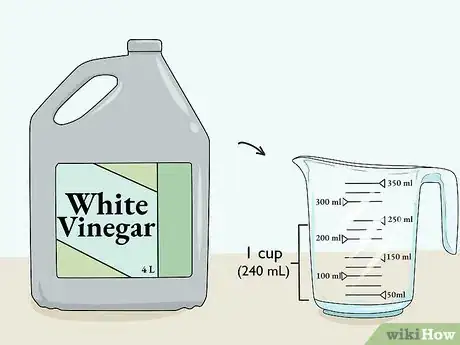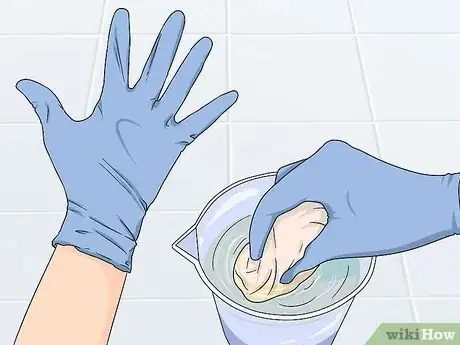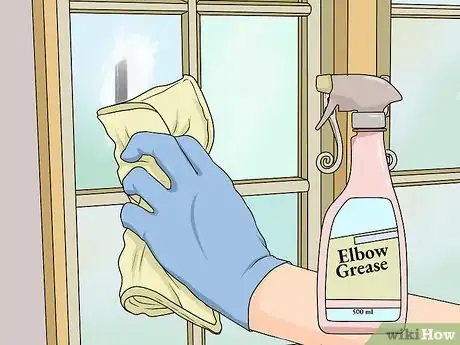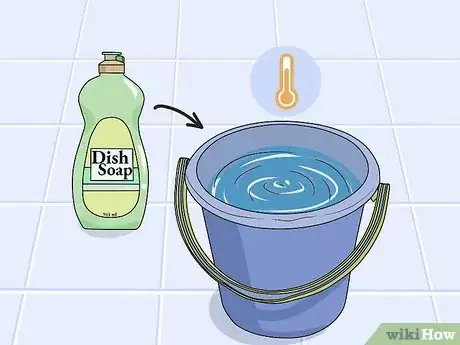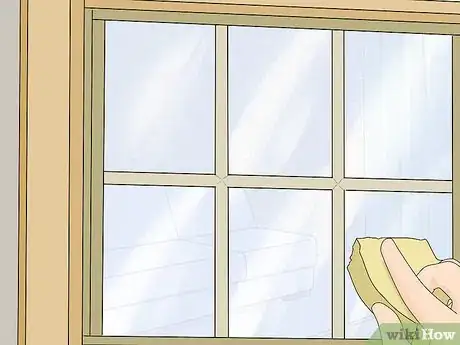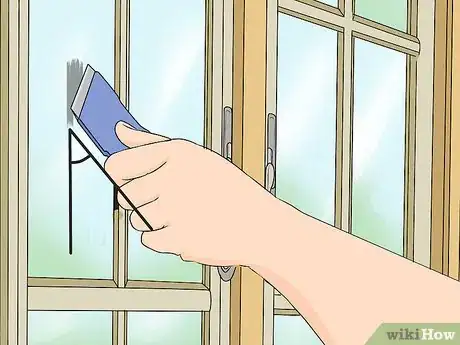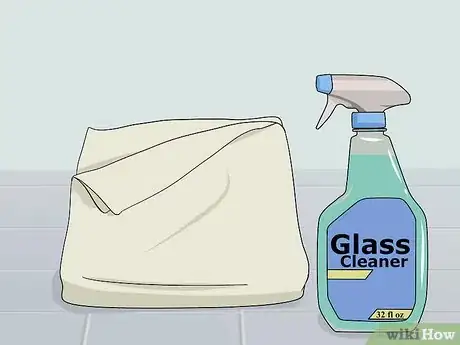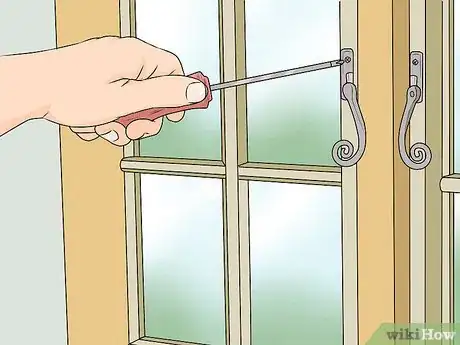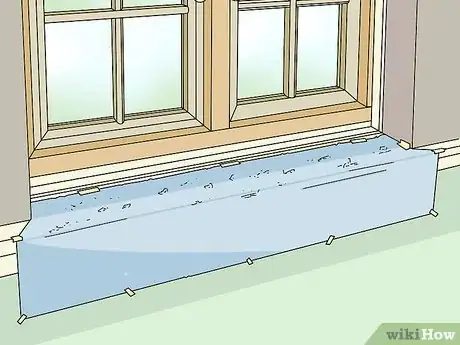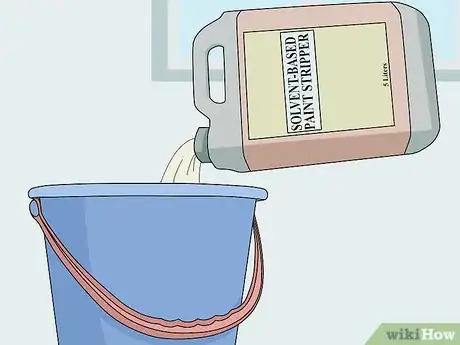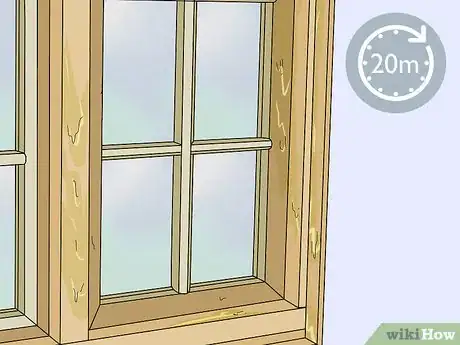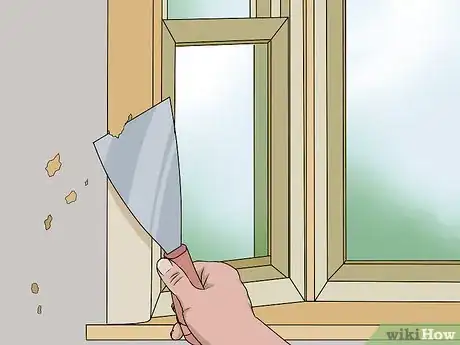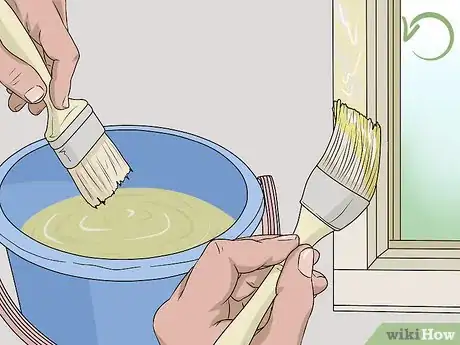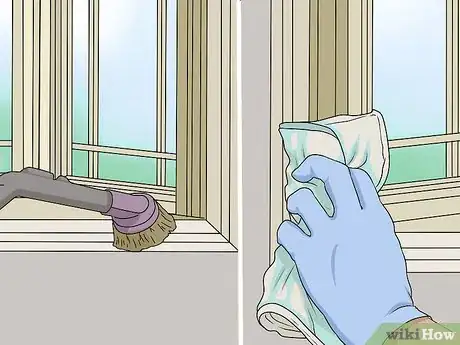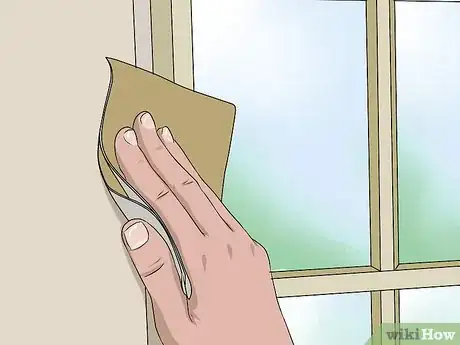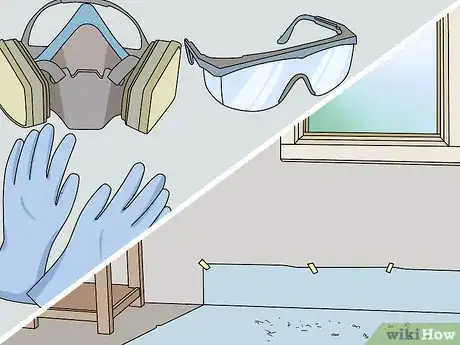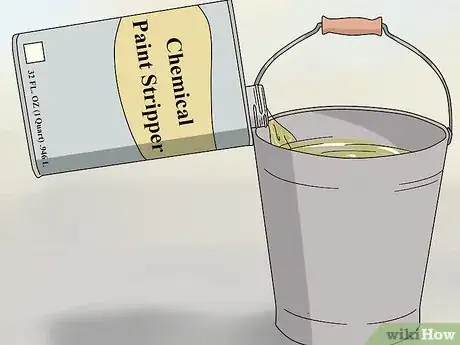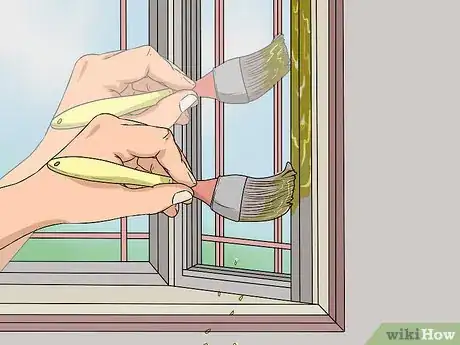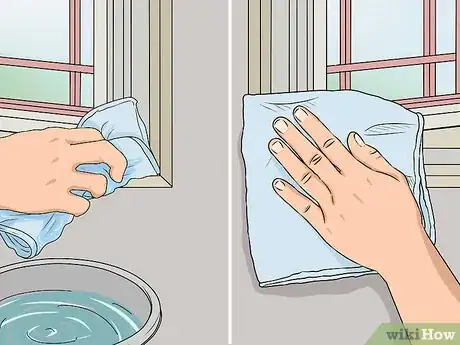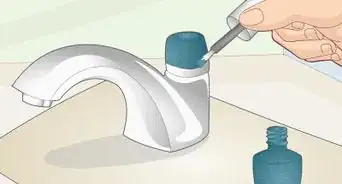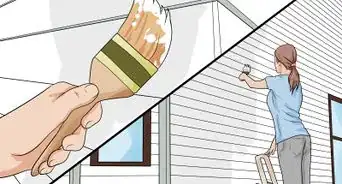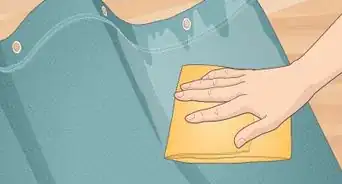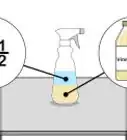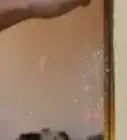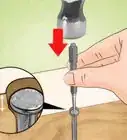This article was co-authored by Ben Barlow. Ben Barlow is a Window Cleaning Specialist and the Owner of Barlow Window Bros based in Provo, Utah. Ben specializes in window and gutter cleaning, power washing, and Christmas light installation. He studied at Brigham Young University.
There are 8 references cited in this article, which can be found at the bottom of the page.
This article has been viewed 572,145 times.
Whether you accidentally got some paint on the window pane during your latest painting session or are looking to refinish old windows, knowing how to remove paint will come in handy as you work on home improvement projects. Take the time to prep the paint the right way to make the removal process that much easier, and be patient as you work on cleaning up the windows. It may take a little bit of time and elbow grease, but you can do it! We’ll walk you through different options to remove paint from glass. Then, we’ll even cover removing paint from window frames and metal windows.
Steps
Scrub the glass with vinegar.
-
1Vinegar is an easy DIY solution that doesn’t involve harsh chemicals. Measure 1 cup (240 mL) of white vinegar into a glass measuring cup. Use a glass measuring cup that is large enough to hold the vinegar and not spill over if you were to dip a rag into it. Use a glass container rather than plastic, since you will need to heat up the vinegar.[1]
- One of the great things about removing paint from glass is that you probably already have everything you need at home. You don’t need to use any chemical-based products—just white vinegar and dish soap should do the trick!
Tip: If you don’t have a glass measuring cup, a microwave-safe glass bowl will work just as well.
-
2Microwave the white vinegar for 30 to 60 seconds until it comes to a boil. There’s no need to cover the bowl, but do keep an eye on it as it heats up so you can stop the microwave once the vinegar starts to bubble. Depending on how strong your microwave is, this might take a little more or less time than indicated.[2]
Tip: Take this opportunity to wipe down the interior of the microwave. The steam from the white vinegar will loosen up any stains or baked-on foods, making them easier to clean up.
Advertisement -
3Put on rubber gloves and dip a clean rag into the white vinegar. The rubber gloves will keep your hands from getting burnt in the hot vinegar. A smaller rag, about the size of a washcloth, works well for this project. A hand towel could be too bulky and get in the way while you’re working.[3]
- You could also use a clean sponge for this step, too.
-
4Scrub the paint with the vinegar-soaked rag. Use some elbow grease to really rub the paint and saturate it with the white vinegar. This should soften the paint, and it may actually completely remove it! If it doesn’t come off yet, that’s totally okay. Just move on to the next method.[4]
- If the paint does come away completely from using the white vinegar, simply spray the window with glass cleaner and wipe it down to clean it off.
Scrub the paint with soap and water.
-
1Fill a bucket with warm water and 1 tablespoon (15 mL) of dish soap. Put the dish soap into the bucket first so it can get sudsy while the bucket is filling with water.[6]
-
2Soak a sponge or rag in the soapy water and wipe down the paint spots. Try your best to do this right after the vinegar step so that the paint doesn’t have a chance to dry again. Really saturate the paint with the soapy water.[7]
- If you’re concerned about the water running down the wall or hitting the floor, lay down a towel underneath of where you’re working.
Strip paint off a window frame.
-
1Remove any hardware from the frame, like nails or handles. There shouldn’t be too much to remove from the window, but if there are old handles, nails, screws, or hinges, take those off and set them to the side. If you have really old windows, put the hardware from each one into a little plastic bag and label the bag so you remember which window the parts go to.[14]
- Similarly, if there is furniture or a rug near the window, move it out of the way at this time so it’ll be kept safe while you work.
-
2Lay down a tarp beneath the window you’ll be stripping. You’ll be working with a chemical product and there will probably be lots of paint chips flaking away, so you want to be able to catch everything so your floor doesn’t get ruined. Use a clean tarp and make sure it completely covers the area directly underneath where you’ll be working.[15]
- If you don’t have a tarp, a sheet of plastic could also work. As a last resort, use an old sheet—it won’t keep spilled liquid from reaching the floor, but it’ll catch those paint chips as you scrape them off.
-
3Put on your protective gear before you start using the paint stripper. Wear protective gloves, safety glasses, and a respirator. If you can, open some windows or run a fan in the room you’ll be working in so that the air doesn’t get too stagnant.[16]
- The respirator goes over your mouth and nose and lets you breathe in clean air even while there are lots of dust, fumes, and paint chips flying around.
-
4Empty a solvent-based paint stripper into a clean bucket. Solvent-based strippers are great for this type of work because they break down the bond that is holding the paint to the wood, making it a lot easier to scrape away. Use a clean bucket that is big enough to safely hold the solvent without it spilling over.[17]
- Visit your local home improvement store to buy a solvent-based paint stripper.
Warning: Always read the manufacturer’s instructions before you begin using this kind of product. Some brands may have different instructions about timing or application that you will need to follow.
-
5Dip a paintbrush into the stripper and paint a small section of the window. Use a clean, inexpensive paintbrush that you can buy at a hardware or home improvement store. Start with working on just one side of the window frame, rather than trying to paint the entire thing all at once. This will expose you to fewer fumes and you can take a break while the stripper is saturating the paint.[18]
- Layer the solvent on as thickly as you can without it running down the wood.
-
6Let the stripper saturate the wood for about 20 minutes. This time might differ depending on what the manufacturer’s instructions specify. Keep an eye out for signs that the stripper is working:[19]
- The paint will start to bubble
- The surface of the paint will look uneven
- Sections of paint may even start to come away from the frame
-
7Use a scraper to remove as much of the treated paint as you can. After the designated amount of time has passed, go ahead and start scraping away at the paint. Use gentle motions and try your best not to knick or gouge the wood underneath.[20]
- If you can get a small section of the paint lifted, it usually will come off in a long strip.
- If there are multiple layers of paint to be removed, you may need to repeat the painting and scraping process several times until you get down to the bare wood.
Working with Lead Paint: Lead paint is most commonly found in homes built prior to 1978. Make sure you cover any carpet with a taped-down tarp so the dust from the paint doesn’t get into it. Use a respirator, goggles, and shoe covers, and use a shop vac to thoroughly clean up the removed paint and dust from the floor and window sill.[21]
-
8Opt for a wire brush to scrape paint away from creases and depressions. If there are smaller moldings in the window frame that aren’t easily accessed with a paint scraper, use a wire brush instead. It’ll allow you to get to those thin sections and clean them out.[22]
- As with the scraper, use gentle motions and avoid gouging the wood with the wire brush.
-
9Repeat the stripper and scraper steps until the frame has been treated. This project may take you a few days, just depending on how much time you have to devote to it each day, but it’ll get done sooner than you think! Focus on doing one entire window at a time before moving on to the next one.[23]
-
10Wipe down the wood with a clean, wet rag. Once the entire frame has been treated and scraped, wet a clean rag in water. Wipe down the frame and windowsill, and don’t forget to get in all the cracks and crevices, too.[24]
- If there are lots of chips of paint, use a shop vac to clean them up first.
-
11Sand the window pane to create a smooth surface. Use a manual sander with 220-grit sandpaper to work away any small scrapes and remove any tiny flecks of paint that remain. Once that is done, you can move on to refinishing the window pane however you’d like.[25]
- Wipe down the frame again after sanding to clear away any dust that remains.
Remove paint from metal windows.
-
1Lay down a tarp and put on your protective gear. Use a tarp or a drop cloth to cover the ground beneath the window to protect the floor from the paint stripper. Put on rubber gloves, goggles, and a respirator before you start working.[26]
- If you can, open some windows or run a fan to help keep the room as well-ventilated as possible while you work.
Tip: Wear long sleeves and pants to protect your skin from spills and drips.
-
2Pour the stripper into a glass or metal bucket so it’s easier to access. Choose a stripper that is made specifically for metal and read the manufacturer’s instructions before you begin using it. Some products will have longer curing times than others, which might affect your decision.[27]
- Never use a plastic or styrofoam container for the stripper, as it could actually eat through the material and leak all over your floor.
-
3Apply the paint stripper to the metal window frame and let it sit. Use a disposable paint brush so that you can just discard it once you’re done working. Apply as thick of a coat of the stripper as you can without having it drip down the frame. Leave the stripper alone to do its work, which usually takes about 20 to 30 minutes.[28]
- As the stripper starts to work, the paint will start to bubble up and peel off of the metal frame.
-
4Scrape away as much of the paint as possible. Use a paint scraper or a nylon brush or scrubbing pad to chip away the peeling paint. If there is more dried paint underneath the first layer, reapply the stripper and repeat the scraping process as many times as needed until the metal is exposed.[29]
- For hard-to-reach crevices, use a wire brush.
-
5Rinse the window frame and then dry it off with a clean rag. Dip a clean rag into water and thoroughly wipe down the window frame to remove any remnants of paint thinner or mineral spirits. After that, take a clean, dry rag and dry off the frame completely. Once that is done, you’re ready to repaint or refinish your metal window frame however you please![30]
Community Q&A
-
QuestionWhich method woks best on hurricane impact windows?
 Community AnswerWhether you have a lot of paint or a little, you can use a scraper to loosen the paint from the glass. Use one that takes a single-edge razor blade, which can be bought for a few dollars at a general or hardware store. Remember to keep the blade as flat as possible against the glass. Take special care when scraping around the edge of the window where the frame is -- you don't want to cut the frame or the caulk that goes between the pane of glass and the frame. When you have loosened all the paint, you can remove the loose bits by wiping with a dry cloth. Then clean all the window panes with a little glass cleaner such as Windex and finish off with a dry lint-free cloth.
Community AnswerWhether you have a lot of paint or a little, you can use a scraper to loosen the paint from the glass. Use one that takes a single-edge razor blade, which can be bought for a few dollars at a general or hardware store. Remember to keep the blade as flat as possible against the glass. Take special care when scraping around the edge of the window where the frame is -- you don't want to cut the frame or the caulk that goes between the pane of glass and the frame. When you have loosened all the paint, you can remove the loose bits by wiping with a dry cloth. Then clean all the window panes with a little glass cleaner such as Windex and finish off with a dry lint-free cloth. -
QuestionIf the paint stains become soft, it is easy to remove them. Now the question is, how do I soften the hard and stubborn paint stains from the glass?
 Community AnswerUse a hair dryer. Heat one area at a time, then use a utility knife (box cutter) to gently remove the paint. Do NOT press too hard, or you will scratch the glass. You can also use a kitchen knife. Wipe with a soft dry cloth, then move on to the next stain. Don't forget to feel for any remaining bumps. If you detect any, remove them the same way.
Community AnswerUse a hair dryer. Heat one area at a time, then use a utility knife (box cutter) to gently remove the paint. Do NOT press too hard, or you will scratch the glass. You can also use a kitchen knife. Wipe with a soft dry cloth, then move on to the next stain. Don't forget to feel for any remaining bumps. If you detect any, remove them the same way. -
QuestionHow do I remove oil-based emulsion from glass?
 Community AnswerSpray Easy-Off oven cleaner, which removes oil and paint. Do not breath the Easy-Off spray, because it's pH burns the lungs. Open all the windows and run outside for a few minutes after spaying the Easy-Off oven cleaner on the windows. Use Windex and a roll of paper towels to clean the paint and Easy-Off from the window.
Community AnswerSpray Easy-Off oven cleaner, which removes oil and paint. Do not breath the Easy-Off spray, because it's pH burns the lungs. Open all the windows and run outside for a few minutes after spaying the Easy-Off oven cleaner on the windows. Use Windex and a roll of paper towels to clean the paint and Easy-Off from the window.
Things You’ll Need
Scraping Paint off of Glass
- Glass measuring cup
- White vinegar
- Rubber gloves
- Clean rags (2 to 3)
- Sponge (optional)
- Small bucket
- Dish soap
- Razor blade
- Glass cleaner
Stripping Paint off of a Window Frame
- Tarp
- Protective gloves
- Safety glasses
- Respirator
- Solvent-based paint stripper
- Bucket
- Paintbrush
- Scraper
- Wire brush
- Clean rags
- Sandpaper
Treating Metal Windows
- Rubber gloves
- Eye protection
- Respirator
- Drop cloth or tarp
- Paint-stripping gel or solvent
- Glass or metal can
- Disposable paintbrushes
- Paint scraper
- Nylon brush or scrubbing pad
- Mineral spirits
References
- ↑ https://www.bobvila.com/articles/how-to-remove-paint-from-glass/
- ↑ https://www.bobvila.com/articles/how-to-remove-paint-from-glass/
- ↑ https://www.bobvila.com/articles/how-to-remove-paint-from-glass/
- ↑ https://www.bobvila.com/articles/how-to-remove-paint-from-glass/
- ↑ https://www.bobvila.com/articles/how-to-remove-paint-from-metal/
- ↑ https://www.bobvila.com/articles/how-to-remove-paint-from-glass/
- ↑ https://www.bobvila.com/articles/how-to-remove-paint-from-glass/
- ↑ https://diypaintingtips.com/remove-paint-nearly-surface/
- ↑ Ben Barlow. Window Cleaning Specialist. Expert Interview. 23 July 2021.
- ↑ https://www.uglyducklinghouse.com/how-to-to-remove-paint-from-windows/
- ↑ Ben Barlow. Window Cleaning Specialist. Expert Interview. 23 July 2021.
- ↑ Ben Barlow. Window Cleaning Specialist. Expert Interview. 23 July 2021.
- ↑ https://www.bobvila.com/articles/how-to-remove-paint-from-glass/
- ↑ https://www.bobvila.com/articles/how-to-remove-paint-from-wood/
- ↑ https://www.bobvila.com/articles/how-to-remove-paint-from-wood/
- ↑ https://www.bobvila.com/articles/how-to-remove-paint-from-wood/
- ↑ https://www.bobvila.com/articles/how-to-remove-paint-from-wood/
- ↑ https://www.bobvila.com/articles/how-to-remove-paint-from-wood/
- ↑ https://www.bobvila.com/articles/how-to-remove-paint-from-wood/
- ↑ https://www.bobvila.com/articles/how-to-remove-paint-from-wood/
- ↑ https://www.familyhandyman.com/smart-homeowner/home-safety-tips/how-to-remove-lead-paint-safely/
- ↑ https://www.bobvila.com/articles/how-to-remove-paint-from-wood/
- ↑ https://www.bobvila.com/articles/how-to-remove-paint-from-wood/
- ↑ https://www.bobvila.com/articles/how-to-remove-paint-from-wood/
- ↑ https://www.bobvila.com/articles/how-to-remove-paint-from-wood/
- ↑ https://www.bobvila.com/articles/how-to-remove-paint-from-metal/
- ↑ https://www.bobvila.com/articles/how-to-remove-paint-from-metal/
- ↑ https://www.bobvila.com/articles/how-to-remove-paint-from-metal/
- ↑ https://www.bobvila.com/articles/how-to-remove-paint-from-metal/
- ↑ https://www.bobvila.com/articles/how-to-remove-paint-from-metal/
- ↑ https://www.familyhandyman.com/painting/avoid-and-remove-paint-drips/
About This Article
To remove paint from window glass, start by heating 1 cup of white vinegar in the microwave for 30-60 seconds. Next, dip a clean rag into the warm vinegar and saturate the paint with the solution. Don't worry if the paint doesn't come off yet! Then, saturate the paint with warm, soapy water to loosen it even more and lubricate the surface. After applying the water, run a razor blade slowly over the painted surface at a 45-degree angle. Use firm pressure, scrape in one direction, and remoisten the paint from time to time with the soapy rag so you don't scratch the glass. Finish by rinsing the glass with fresh water and wiping it down with window cleaner. For tips on using chemical solvents to strip paint off window frames, read on!
